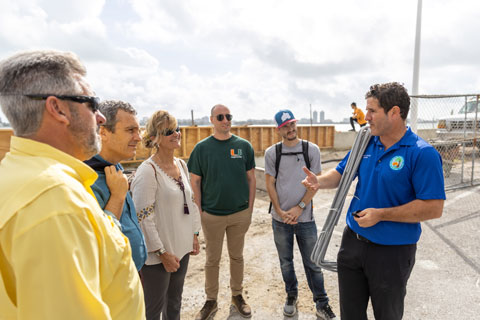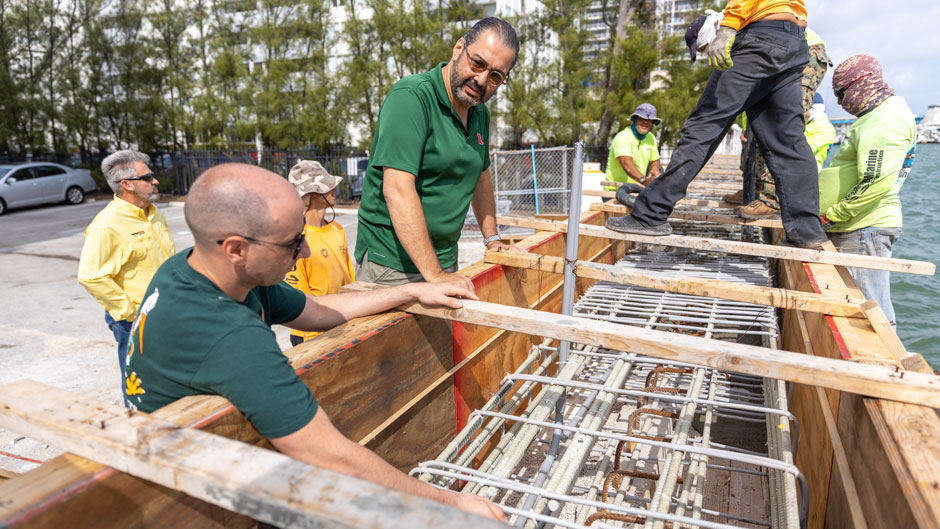The community of North Bay Village took a step to protect its future on Tuesday by implementing a new concept designed by University of Miami faculty members and graduate students to prolong the life of seawalls that encircle the island village in Biscayne Bay.
Workers poured 50 feet of concrete to build the top of a seawall on the eastern edge of the village. But it was not a typical seawall. This one was fortified with a material called glass fiber reinforced polymer (GFRP) rebar—which College of Engineering researchers said can help the seawall last much longer. Although steel rebar is more commonly used in construction today, with time, seawater often corrodes the frame and weakens the entire structure, said Roberto Rodriguez, a Ph.D. student at the college.
“It’s a small success, but hopefully this will lead to a lot of future projects with this material in South Florida,” Rodriguez said. “Today we took the first step in proving that GFRP technology is a viable solution for seawall construction.”
The idea for a test section of the seawall occurred last fall when North Bay Village Mayor Brent Latham and Village Manager Ralph Rosado visited campusand spoke with Antonio Nanni, College of Engineering professor and chair of the Civil, Architectural, and Environmental Engineering Department. They liked his ideas about using GFRP to extend the life of concrete structures and collaborated with a condominium association that owns the property to provide the last 50-foot section for the experiment. Rodriguez designed a frame for the seawall cap using GFRP, and it was put in place on Tuesday.

“This can extend the life of the seawall from an average of 20 to 30 years to more like 100,” said Latham, who also noted that the village is updating its building codes to include a seven-foot high seawall requirement. “If we build better, higher seawalls, we don’t have to worry as much, and it becomes a more economically compelling solution.”
North Bay Village leaders are looking for any novel ways that the community of 10,000 residents can protect itself from storm surge and sea level rise. The three islands that make up the village are surrounded by five miles of seawall, but Latham estimates that 80 percent to 90 percent of that is below the new seven-foot code because of an acceleration in sea level rise that builders did not anticipate.
During the fall visit, Latham and Rosado also met with a University Laboratory for Integrative Knowledge (U-LINK) team led by engineering professors Prannoy Suraneni and Esber Andiroglu to explore the next generation of coastal structures in Miami. They hope to develop multi-functional seawalls using plants and man-made solutions, which not only prevent coastal erosion, but also contribute to healthier bay water quality. This is a significant concern for South Florida communities that are especially vulnerable to sea level rise and storm surge, Andiroglu said. He and biology professor Kathleen Sullivan Sealey, also on the U-LINK team, watched as the new seawall was poured.
“Since they are building seawalls around the entire community of North Bay Village, it gives us the opportunity to deploy other innovative structures that our U-LINK team is currently working on,” Andiroglu said.
The University and North Bay Village officials are already talking about collaborating on future seawall projects, where innovative ideas such as the use of Seacon, or concrete that uses seawater, can be utilized. In addition, Andiroglu said that village officials are interested in using another innovation developed by engineering professor Landolf Rhode-Barbarigos called SEAHIVE, which is a perforated hexagonal tube that can be used to dissipate wave energy and prevent shoreline decay, while also supporting healthier marine life.

